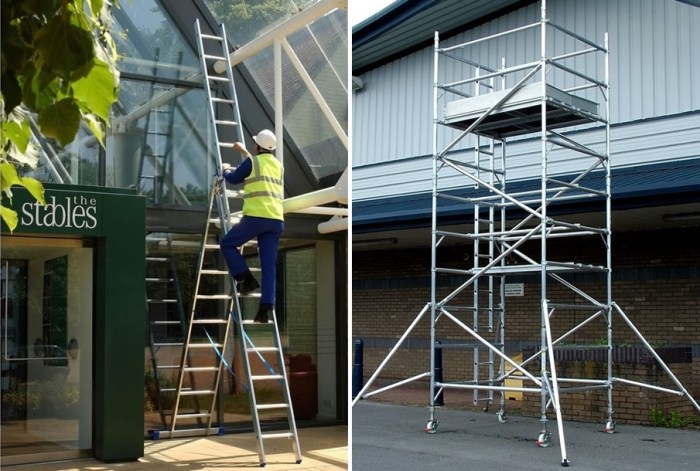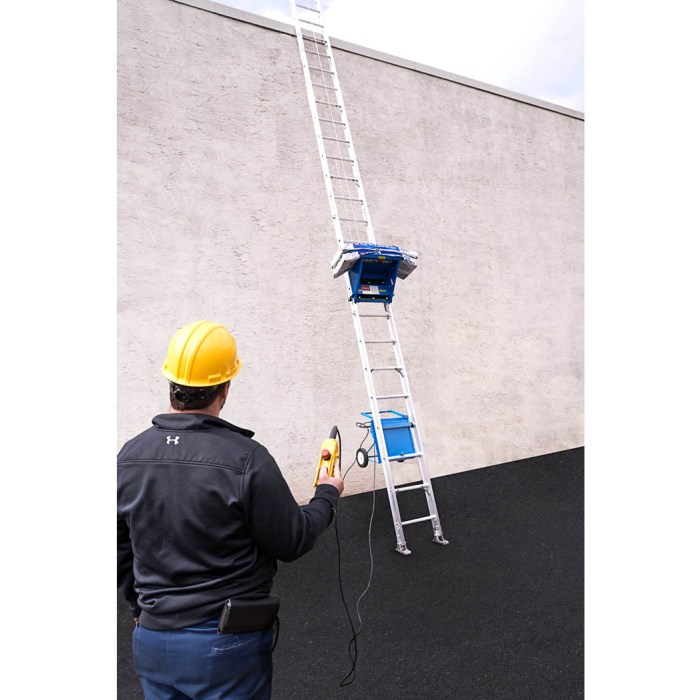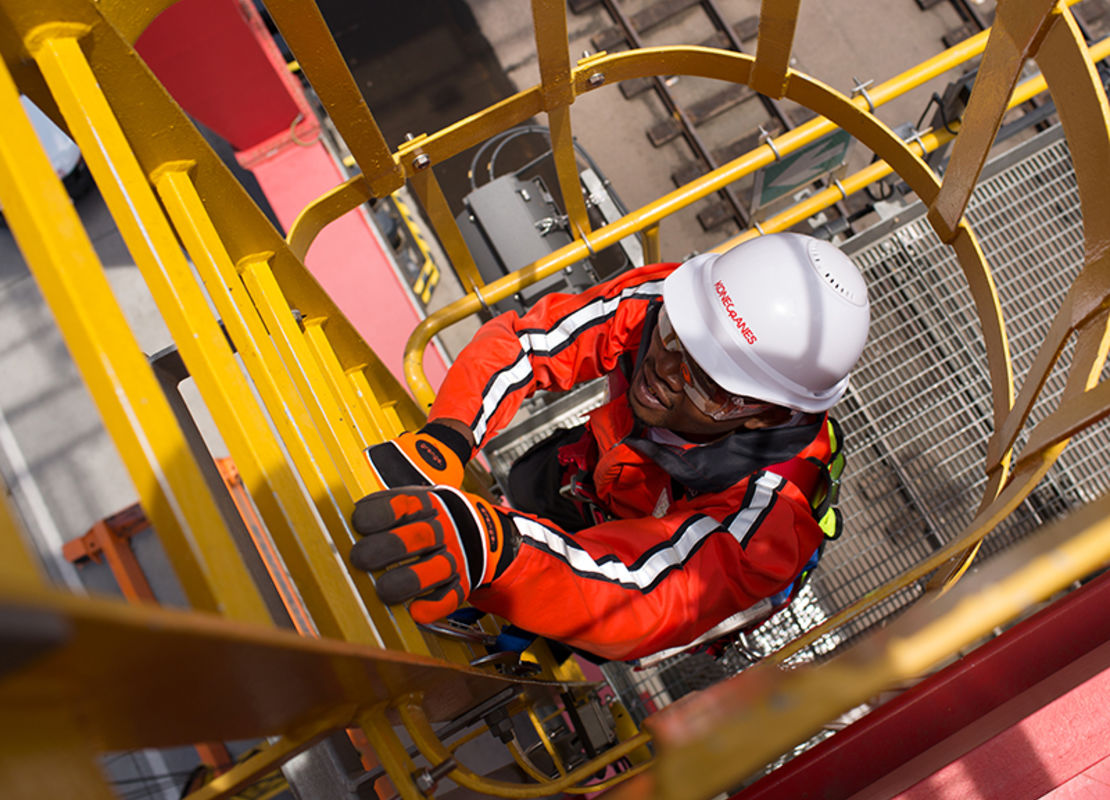Cranes ladders scaffolds backhoes and paint rollers – In the realm of construction and maintenance, the utilization of cranes, ladders, scaffolds, backhoes, and paint rollers is paramount. These versatile tools play a crucial role in facilitating a wide range of tasks, from reaching towering heights to performing intricate repairs.
Understanding their functions, applications, and safety protocols is essential for ensuring efficient and safe operations.
This comprehensive guide delves into the intricacies of each piece of equipment, providing insights into their designs, benefits, and best practices. By exploring the diverse applications of cranes, ladders, scaffolds, backhoes, and paint rollers, we uncover their indispensable role in shaping the built environment and maintaining its integrity.
Cranes: Types and Applications
Cranes are indispensable equipment in various industries, particularly construction and manufacturing. These powerful machines facilitate the lifting, lowering, and precise placement of heavy loads. Cranes come in diverse types, each designed for specific applications and environments.
Tower Cranes
Tower cranes are commonly used in high-rise construction projects. These cranes feature a vertical mast that supports a horizontal jib. The jib can rotate 360 degrees, providing excellent reach and maneuverability. Tower cranes are ideal for lifting and placing heavy materials at great heights.
Mobile Cranes
Mobile cranes are versatile machines that can be transported and set up quickly on different job sites. They have a telescopic boom that can be extended and retracted, allowing them to reach various heights and distances. Mobile cranes are suitable for a wide range of applications, including construction, infrastructure projects, and industrial maintenance.
Rough Terrain Cranes
Rough terrain cranes are designed to operate on uneven and challenging terrain. They feature large tires and a sturdy frame that enables them to navigate rough surfaces. Rough terrain cranes are commonly used in construction projects in remote areas or where access is limited.
Benefits of Using Ladders

Ladders are essential tools for accessing heights and reaching hard-to-reach areas. They offer numerous advantages in various tasks, including:
Height Access
Ladders provide a safe and convenient way to reach elevated areas, such as roofs, ceilings, and storage units. They are indispensable for tasks like painting, cleaning, and maintenance.
Versatility
Ladders come in various sizes and designs, making them suitable for a wide range of applications. They can be used both indoors and outdoors, in both commercial and residential settings.
Compact Storage
Ladders are relatively compact when folded, making them easy to store in small spaces. This is particularly advantageous for homeowners and businesses with limited storage capacity.
Scaffolding for Construction Projects: Cranes Ladders Scaffolds Backhoes And Paint Rollers

Scaffolding plays a crucial role in construction projects, providing a safe and stable platform for workers to perform tasks at heights. It consists of several components, including:
Standards
Standards are vertical supports that form the main structure of the scaffolding. They are typically made of steel or aluminum and are designed to bear the weight of the platform and workers.
Ledgers
Ledgers are horizontal supports that connect the standards and provide a surface for the platform to rest on. They are usually made of steel or aluminum and are spaced at regular intervals.
Braces
Braces are diagonal supports that connect the standards and ledgers, providing stability and preventing the scaffolding from collapsing. They are typically made of steel or aluminum and are installed at various angles.
Backhoes: Functions and Applications

Backhoes are versatile earthmoving machines that combine a digging bucket with a hydraulic arm. They are commonly used in construction, agriculture, landscaping, and other industries.
Digging Trenches
Backhoes are ideal for digging trenches for pipelines, cables, and drainage systems. The digging bucket can be adjusted to different angles, allowing for precise excavation.
Excavation
Backhoes can be used for small-scale excavation projects, such as digging foundations, ponds, and swimming pools. The hydraulic arm provides the necessary power and reach for efficient excavation.
Loading and Unloading
Backhoes can also be equipped with attachments, such as grapples or forks, for loading and unloading materials. This makes them versatile machines for various tasks on construction sites and farms.
Paint Rollers: Techniques and Applications
Paint rollers are widely used tools for applying paint to surfaces. They come in various types, each suited for specific applications and surfaces.
Foam Rollers
Foam rollers are ideal for smooth surfaces, such as walls and ceilings. They provide a smooth, even finish and are suitable for both latex and oil-based paints.
Nap Rollers
Nap rollers have a thicker pile, making them suitable for rougher surfaces, such as textured walls and exterior surfaces. The nap length determines the thickness of the paint application.
Techniques
Proper roller technique is crucial for achieving a smooth and professional finish. Rollers should be loaded evenly with paint and applied with light, even strokes. Overlapping strokes should be avoided to prevent streaks.
Safety Regulations for Construction Equipment
Safety regulations for construction equipment are essential to ensure the safety of workers and prevent accidents. These regulations cover various aspects of equipment operation, maintenance, and inspection.
Operator Training
All operators of construction equipment must receive adequate training and certification. This training covers the safe operation of the equipment, as well as emergency procedures.
Equipment Maintenance
Regular maintenance is crucial to ensure the safe operation of construction equipment. This includes inspections, repairs, and lubrication as per manufacturer’s recommendations.
Inspection and Testing
Construction equipment should be inspected and tested regularly to identify any potential hazards or defects. This helps prevent accidents and ensures the equipment is in good working condition.
Maintenance and Inspection of Equipment
Proper maintenance and inspection of construction equipment are essential for safety and longevity. Regular maintenance tasks include:
Lubrication, Cranes ladders scaffolds backhoes and paint rollers
All moving parts of construction equipment require regular lubrication to reduce friction and wear. This helps extend the equipment’s lifespan and prevents breakdowns.
Inspections
Regular inspections should be conducted to identify any potential hazards or defects. These inspections should be thorough and cover all aspects of the equipment, including structural components, hydraulic systems, and electrical wiring.
Repairs
Any identified defects or malfunctions should be repaired promptly to prevent further damage or accidents. Repairs should be carried out by qualified technicians using genuine parts.
Question Bank
What are the different types of cranes?
Cranes come in various types, including mobile cranes, tower cranes, crawler cranes, and overhead cranes, each designed for specific applications and load capacities.
What are the safety precautions for using ladders?
When using ladders, it is crucial to ensure they are placed on stable surfaces, fully extended, and secured against movement. Proper body mechanics and maintaining three points of contact while climbing are essential for safety.
What is the role of scaffolding in construction projects?
Scaffolding provides a safe and stable platform for workers to access heights during construction, maintenance, and repair tasks. It consists of frames, platforms, and guardrails, and must be properly assembled and inspected before use.
What are the functions of backhoes?
Backhoes are versatile machines used for digging, trenching, and loading materials. They consist of a hydraulic arm with a bucket attachment, allowing for precise excavation and earthmoving operations.
What are the techniques for using paint rollers?
Paint rollers come in various materials and sizes, suitable for different surfaces and paint types. Proper techniques involve applying even pressure, maintaining a consistent rolling speed, and overlapping strokes to achieve a smooth and uniform finish.